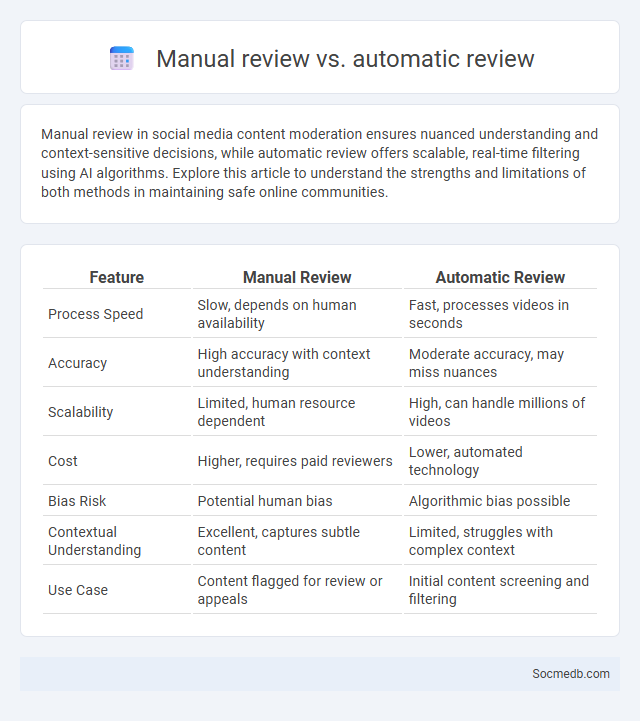
Photo illustration: Manual review vs Automatic review
Manual review in social media content moderation ensures nuanced understanding and context-sensitive decisions, while automatic review offers scalable, real-time filtering using AI algorithms. Explore this article to understand the strengths and limitations of both methods in maintaining safe online communities.
Table of Comparison
| Feature | Manual Review | Automatic Review |
|---|---|---|
| Process Speed | Slow, depends on human availability | Fast, processes videos in seconds |
| Accuracy | High accuracy with context understanding | Moderate accuracy, may miss nuances |
| Scalability | Limited, human resource dependent | High, can handle millions of videos |
| Cost | Higher, requires paid reviewers | Lower, automated technology |
| Bias Risk | Potential human bias | Algorithmic bias possible |
| Contextual Understanding | Excellent, captures subtle content | Limited, struggles with complex context |
| Use Case | Content flagged for review or appeals | Initial content screening and filtering |
Understanding Manual Review in Content Monetization
Manual review in content monetization involves human evaluators assessing your social media posts to ensure they comply with platform policies and advertising standards. This process helps identify inappropriate or low-quality content that automated systems might miss, directly impacting your ability to generate revenue. Understanding manual review criteria enables you to optimize your content strategy for sustained monetization success.
The Role of Automatic Review Systems
Automatic review systems play a critical role in moderating social media content by quickly identifying and filtering harmful or inappropriate posts using artificial intelligence and machine learning algorithms. These systems enhance platform safety by reducing the spread of misinformation, hate speech, and spam, ensuring compliance with community guidelines. Continuous improvements in natural language processing and image recognition technologies enable automatic review systems to handle the vast volume of daily user-generated content more effectively.
What is the Yellow Dollar Sign on YouTube?
The yellow dollar sign on YouTube indicates limited or no monetization on a video due to content that may not be advertiser-friendly or is under review for copyright claims. Your videos marked with this yellow icon might generate lower ad revenue or have restricted ads. Understanding the yellow dollar sign helps you optimize your content to comply with YouTube's monetization policies and maximize earnings.
Comparing Manual vs Automatic Content Reviews
Manual content reviews on social media involve human moderators who analyze posts for policy violations, ensuring nuanced understanding and context recognition but often facing scalability challenges. Automatic content reviews utilize AI algorithms and machine learning to rapidly detect inappropriate or harmful content, enhancing speed and consistency but sometimes lacking accuracy in complex or ambiguous situations. Combining manual and automatic reviews can optimize content moderation by balancing efficiency with contextual sensitivity, improving overall platform safety and user experience.
Impact of Review Methods on Ad Revenue
Review methods significantly influence ad revenue across social media platforms by shaping content quality and user trust. Effective moderation improves user engagement, increasing ad impressions and click-through rates that drive higher revenue for advertisers. Your brand benefits when transparent, consistent review practices foster authentic interactions that attract targeted advertising budgets.
Triggers for Manual Review Activation
Triggers for manual review activation on social media platforms include suspicious account behavior, such as rapid posting, unusual login attempts, or content flagged for violating community guidelines. Algorithms detect patterns like spam, hate speech, or misinformation, prompting human moderators to verify authenticity and adherence to policies. Your content may be manually reviewed to ensure safety, accuracy, and compliance with platform standards.
Accuracy and Limitations of Automatic Reviews
Automatic reviews on social media platforms utilize natural language processing algorithms to analyze user feedback, providing rapid sentiment analysis and trend identification. However, these systems often face limitations in accurately interpreting sarcasm, context, and nuanced opinions, leading to potential misclassifications. Enhancing accuracy requires continuous model training with diverse datasets and integrating human oversight to better capture the complexities of online discourse.
How the Yellow Dollar Sign Affects Monetization
The yellow dollar sign on social media platforms indicates limited or no monetization eligibility, impacting Your ability to earn revenue from ads or sponsored content. This symbol often appears due to content that violates platform guidelines or contains copyrighted material, reducing Your earnings potential. Understanding the yellow dollar sign helps optimize content strategies to maintain full monetization privileges and maximize revenue.
Best Practices for Avoiding Demonetization
Maintaining consistent content quality and adhering to platform community guidelines are essential best practices for avoiding social media demonetization. Utilizing accurate metadata, avoiding copyrighted material, and creating advertiser-friendly content increase monetization stability on platforms like YouTube and Facebook. Regularly reviewing policy updates ensures creators stay compliant and safeguard revenue streams from algorithm changes.
Future Trends in Content Review and Monetization
Future trends in social media content review will leverage advanced AI algorithms to detect harmful material with greater accuracy and speed, ensuring safer online environments. Monetization strategies will increasingly rely on personalized content promotion and direct creator-to-audience financial interactions, such as live shopping and decentralized payment systems. Your social media experience will become more secure and financially rewarding through these innovative technological advancements.
 socmedb.com
socmedb.com